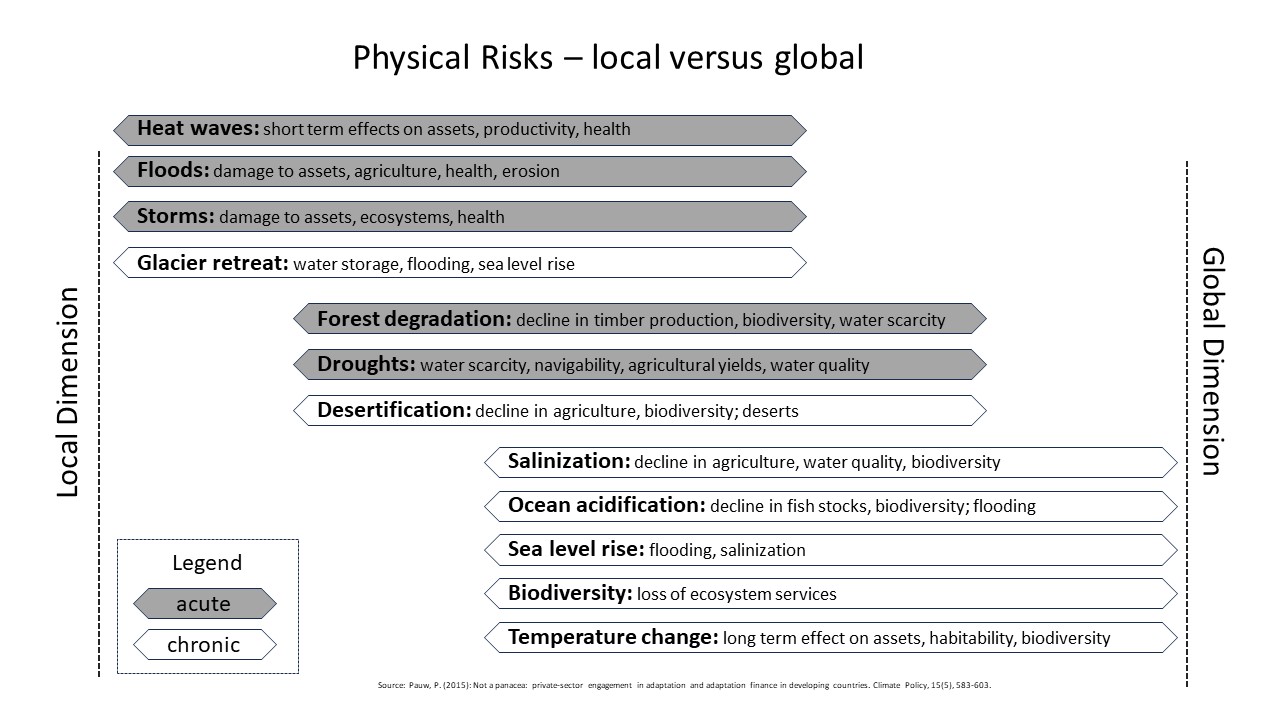
This article was published in full in the July/August 2024 issue of Corporate Finance magazine, Fachmedien Otto Schmidt.
Abstract
Physical risks and their consequences have been increasingly present in the media in recent months: All around the world we have seen images of forest fires, prolonged periods of drought or flooding. These disasters cause human suffering and, at the same time, raise the awareness of environmental changes. Companies in the non-financial and financial sectors are also increasingly experiencing the financial impact of physical risks, which are reflected in balance sheets and income statements. This article is a “call to action” to take a closer look at the topic.
Introduction
A globalized economy offers economic opportunities for companies and, at the same time, means participation in global risks. However, climate and environmental risks have long been topics that have not received a great deal of attention in Germany and many parts of Europe. Until a few years ago, floods, forest fires or prolonged droughts were comparatively rare in Central Europe. Now, however, new heat records and the increase in extreme weather events are pointing in a direction that makes it clear that more attention needs to be paid to this risk area and its financial impact.
When it comes to climate and the environment, it is not enough to focus on just one region. Many companies based in Europe operate production sites across continents and/or are globally networked via supply chains. If we now take a global view, the Global Risks Report[1] of the World Economic Forum (WEF) shows a clear picture over the years: extreme weather events and changing climatic conditions are among the greatest medium-term risks for the economy and society. The WEF’s 2024 Report identifies the four biggest risks for the next ten years in the climate and environment sector:
1. extreme weather events
2. critical changes to the earth’s systems
3. biodiversity loss and ecosystem collapse
4. scarcity of natural resources
The damage caused by natural disasters in the past year alone shows that extreme weather events are already the most serious risk: Munich Re puts these losses at around USD 250 billion worldwide. The reinsurer points out that high temperatures favor global weather catastrophes and that the trend towards warmer temperatures is mainly due to climate change.[2]
The risks that companies face in connection with climate change and changing environmental conditions are divided into physical risks and transition risks.
Physical risks are risks that can arise for a company from the physical effects of climate change. The term acute physical risks covers certain events such as storms, floods, heat waves or forest fires. Chronic physical risks arise from longer-term climate changes caused, for example, by a rise in sea level or an increase in temperature. Transition risks exist for a company in connection with the transition to a low-carbon, more sustainable economy. They can relate to political and legal risks, technological risks and market and reputational risks.[3]
[3] Europäische Kommission (2019), Leitfaden für die Berichterstattung über nichtfinanzielle Informationen: Nachtrag zur klimabezogenen Berichterstattung (2019/ C 209/01)
Companies can be both affected by and responsible for emissions. External climate and environmental influences can have a financial impact on companies which is referred to as “financial materiality”. In the same way, their own economic activities can have an impact on the climate and the environment (“impact materiality”). This article deals with the first aspect, the so-called outside-in perspective, and shows how physical climate risks can impact various P&L and balance sheet items of companies.
Need for action in the management of physical risks
One of the major challenges with regard to physical risks is the uncertainty in the probability of occurrence, the exact timing and the intensity or extent of a loss event, which in extreme cases can even threaten a company’s existence. Such events can directly damage a company or parts of its business operations. Companies are therefore required to gradually strengthen their comprehensive risk management system to include physical risks. This includes a risk inventory analysis as part of climate and environmental due diligence exercise – if possible along the entire value chain – determining the local and global impact and integrating the financial impact of damage scenarios into the financial strategy and planning (see Figure 1).

Assessing the current and potential financial impact of physical risks is therefore very important. On the one hand, loss events can have a direct financial impact on the company’s balance sheet through lower asset values, and on the income statement through higher expenses required for reconstruction or through lower earnings in the event of production interruptions. On the other hand, the more permanent consequences of physical risks are also relevant to the company’s success.


The complete article by Johannes Hofinger (left) and Sandra Reich (right) can be found in German on the gated website at the following link: Physische Risiken – Wie Extremwetter und hohe Temperaturen auf die G&V und Bilanz von Unternehmen wirken
[1] The Global Risks Report 2024, 19th Edition, Insight Report, World Economic Forum, January 2024
[2] cf. https://www.munichre.com/de/unternehmen/media-relations/medieninformationen-und-unternehmensnachrichten/medieninformationen/2024/natural-disaster-figures-2023.html, (Accessed: 9.5.2024)





